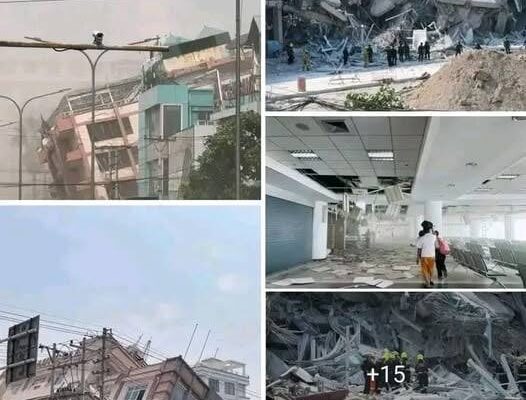Massive 7.7 Earthquake Devastates Parts of Asia, Triggers Widespread Emergency Response
A large-scale humanitarian emergency is rapidly unfolding in parts of Asia after a powerful 7.7 magnitude earthquakestruck in the early hours of Monday morning, causing widespread devastation across Myanmar, southern China, and northern Thailand. The tremor shook the region awake at 3:42 a.m. local time, sending panic through urban and rural communities alike.
According to the United States Geological Survey (USGS), the earthquake’s epicenter was located in a remote mountainous zone along the border between Myanmar’s Shan State and China’s Yunnan Province. Striking at a shallow depth of only 10 kilometers, the seismic force was enough to cause widespread structural collapse and trigger landslides across vulnerable terrain.
Widespread Destruction and Human Tragedy
In the initial hours after the quake, dozens of fatalities were reported, with hundreds more injured and countless others feared to be trapped beneath rubble. Cries for help echoed through crumbled neighborhoods as rescue teams struggled to navigate blocked roads and destroyed infrastructure to reach the most affected zones. Videos circulating on social media captured scenes of collapsed apartment buildings, flattened schools, and roads split open, while panicked residents attempted to dig through debris with bare hands.
In northern Thailand, cities like Chiang Rai and Chiang Mai experienced intense shaking that led to the immediate evacuation of buildings. Authorities there acted swiftly, issuing precautionary alerts and coordinating emergency protocols to minimize further injuries from anticipated aftershocks, which are continuing to shake the region.
Swift but Strained Emergency Response
Governments across the region have mobilized thousands of emergency personnel, including soldiers, medics, firefighters, and civilian volunteers. Temporary shelters have been established in parks, schools, and religious centers for displaced families, some of whom fled their homes with nothing but the clothes on their backs.
In Myanmar, rescue efforts are being hindered by ongoing political instability and difficult terrain, while in China, emergency response units were deployed within hours from Yunnan’s capital, Kunming. Mobile hospitals, trauma centers, and blood donation units are being set up in the disaster zones, but many local hospitals are at capacity, overwhelmed by a steady stream of victims suffering from fractures, head trauma, and burns.
The situation is further complicated by communication blackouts, particularly in remote villages near the epicenter. Severed phone lines, internet outages, and downed power grids are slowing coordination efforts and leaving some communities entirely cut off from aid. Rescue dogs and drones have been deployed to help locate survivors in areas inaccessible by vehicle or foot.
A Region on Edge
The quake’s impact extended far beyond the immediate vicinity. Shocks were felt as far away as Bangkok, more than 700 kilometers south, where tall buildings swayed for several seconds. Residents reported a lingering sense of dizziness and disorientation.
Authorities continue to warn of aftershocks, some of which have registered above magnitude 5.0. Experts fear that further tremors could cause more buildings—already structurally compromised—to collapse, endangering rescue workers and residents alike.
This earthquake has reignited concerns about Asia’s vulnerability to seismic activity, especially in the so-called “Ring of Fire”, an area of frequent earthquakes and volcanic eruptions. Myanmar, in particular, sits on a complex fault system that has been responsible for several deadly quakes over the last few decades.
International Support and Local Solidarity
In a rare display of cross-border solidarity, the governments of Myanmar, China, and Thailand issued coordinated statements pledging mutual aid and cooperation in rescue and recovery efforts. Offers of international assistance have begun to arrive from neighboring countries and global humanitarian organizations, including the Red Cross and UN disaster response teams.
Local communities are also rising to the occasion. Civilians have formed volunteer search squads, organized food drives, and opened their homes to survivors. In border towns, Buddhist temples and churches have become hubs for grief counseling, donations, and rescue coordination.
A Wake-Up Call for Preparedness
As the region reels from the devastation, experts are urging renewed investments in earthquake-resistant infrastructure, public awareness, and emergency preparedness training. The quake serves as a grim reminder of the unpredictable nature of such disasters and the high cost of being unprepared.
In the coming days, the priority will be search and rescue, followed by medical treatment, rebuilding efforts, and psychological support for thousands who have lost their homes, loved ones, and sense of security.
For now, entire communities are gripped by uncertainty—hoping for miracles beneath the rubble, praying for stability, and bracing for what comes next.



